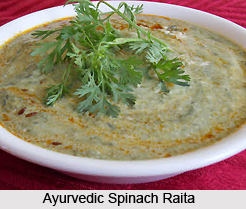 Ayurvedic Spinach Raita is loaded with various health benefits. Spinach known as `Palankya` in Ayurveda is a good blood purifier. Spinach is heavy, sweet, dry, producer of Vata on digestion, cold in potency, purgative and diuretic. It reduces oedema, burning sensation. The spices used in this raita are also good for the health. The raita can be relished with rice or roti for a satisfying and healthy meal. It also makes a delicious dip. Ayurvedic spinach raita is easy to prepare and can be made at home.
Ayurvedic Spinach Raita is loaded with various health benefits. Spinach known as `Palankya` in Ayurveda is a good blood purifier. Spinach is heavy, sweet, dry, producer of Vata on digestion, cold in potency, purgative and diuretic. It reduces oedema, burning sensation. The spices used in this raita are also good for the health. The raita can be relished with rice or roti for a satisfying and healthy meal. It also makes a delicious dip. Ayurvedic spinach raita is easy to prepare and can be made at home.
Ingredients of Ayurvedic Spinach Raita
•Two tablespoon of ghee
•One bunch of raw spinach making about four cups
•Half teaspoon of black mustard seeds
•Half teaspoon of cumin seeds
•A pinch of hing
•Two tablespoon of chopped coriander leaves
•Four fresh curry leaves
•Half green chilli chopped
•Half-cup ground and roasted peanuts
•One-cup plain yogurt
•One-fourth teaspoon of salt
Method of Preparing Ayurvedic Spinach Raita
•To prepare the Ayurvedic spinach raita, first remove the stems of spinach. Wash the spinach and chop it finely. Keep it aside.
•Heat the ghee in a saucepan, on medium flame.
•Add the mustard seeds, cumin seeds, curry leaves followed by hing. Stir gently till the seeds pop out.
•Add the coriander leaves and chilli and remove it from fire. In a bowl gently mix the spinach, yogurt, peanuts and salt.
•Add cooled spices and stir.
•Serve.
Benefits of Ayurvedic Spinach Raita
•Ayurvedic spinach raita is very nutritious and is a great way to get greens vitamins.
•It helps in strengthening eyesight like most green vegetables.
•The raita is low on calories and is good for stomach.
Caution about Ayurvedic Spinach Raita
The spices used in this recipe will help to alleviate some of the rough and cooling qualities of spinach, but Vata and Pitta prakriti people should take it occasionally and when needed for medicinal use. Also people suffering from kidney stones or gall bladder stones should not take it.




















